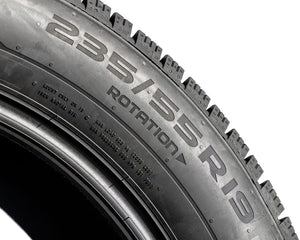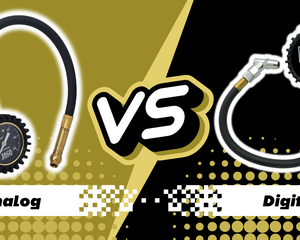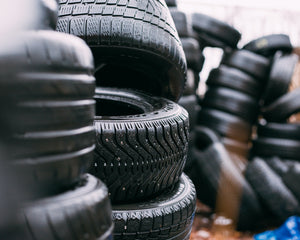
Properly inflated tires are essential for safe driving. Maintaining the correct tire pressure ensures optimal handling, stability, and braking performance. However, despite our best efforts, situations can arise where we find ourselves driving on a flat tire. It's important to understand the risks and consequences associated with this scenario.
A flat tire can occur due to various reasons, such as a puncture, gradual air leakage, or a sudden blowout. Regardless of the cause, driving on a flat tire poses significant dangers and can lead to severe consequences for both the tire and your safety on the road.
The Risks of Driving on a Flat Tire
When a tire loses air pressure and becomes flat, it significantly impacts the tire's structure and performance. Driving on a flat tire can cause irreversible damage and expose you to various risks. Let's explore the potential consequences in detail:
Tire Damage
Structural Damage: Driving on a flat tire places immense stress on its structure. The weight of the vehicle presses down on the flattened tire, causing it to flex and distort in unnatural ways. This can result in permanent damage to the tire's internal components, including the sidewalls, belts, and tread.
Sidewall Damage: The sidewalls of a tire are particularly vulnerable when driving on a flat tire. Without sufficient air pressure to support the tire's shape, the sidewalls can become pinched, compressed, or even scraped against the rim of the wheel. This can lead to sidewall bulges, cuts, or other forms of damage that compromise the tire's integrity.
Punctures: Driving on a flat tire increases the risk of punctures. When the tire loses air pressure, the sidewalls can collapse, exposing the tire's interior to potential hazards on the road. Debris, sharp objects, or even the rim itself can puncture the tire, causing further damage and potential blowouts.
Driving on a flat tire not only puts the tire itself at risk but also compromises your safety as a driver. The handling and control of the vehicle are severely affected, increasing the chances of accidents, loss of control, and other hazardous situations.

Loss of Control and Handling Issues
When a tire goes flat, it significantly affects the stability and control of the vehicle, making driving a challenging and potentially dangerous task.
Steering becomes more difficult as the flat tire disrupts the balance between all the tires. The vehicle may pull to one side, making it harder to maintain a straight path. You may find yourself constantly correcting the steering to compensate for the imbalance caused by the flat tire.
Maneuverability is also compromised. Quick turns or evasive maneuvers become more challenging, as the flat tire hampers the responsiveness of the vehicle. This reduction in maneuverability can be particularly hazardous in emergency situations where split-second decisions are crucial.
Increased Risk of Accidents
Driving on a flat tire significantly increases the risk of accidents and compromises overall road safety. Here are some of the potential hazards and safety risks associated with driving on a flat tire:
Loss of Traction
A flat tire reduces the tire's contact with the road surface, leading to a loss of traction. Traction is essential for maintaining control during acceleration, braking, and cornering. With reduced traction, the vehicle becomes more prone to sliding, skidding, or hydroplaning, especially in wet or slippery conditions.
Skidding and Stability Issues
Driving on a flat tire can cause the vehicle to skid or slide, particularly during abrupt maneuvers or when encountering uneven road surfaces. The compromised stability makes it difficult to maintain control over the vehicle, increasing the risk of accidents.
Potential Accidents
The combination of compromised steering, reduced maneuverability, loss of traction, and stability issues significantly raises the likelihood of accidents. It becomes more challenging to respond to sudden obstacles, navigate sharp turns, or safely stop the vehicle in a timely manner. This puts you, your passengers, and other road users at risk.
It's crucial to recognize the dangers of driving on a flat tire and take immediate action to address the issue. Ignoring a flat tire and continuing to drive can have severe consequences, both for your safety and the well-being of others on the road.

Further Damage to the Wheel and Suspension
Driving on a flat tire not only affects the tire itself but also poses risks to other crucial components of your vehicle, such as the wheel and suspension system.
When a tire is flat, the weight of the vehicle presses down on the wheel and suspension components unevenly. This uneven stress can lead to damage or premature wear on these parts. The impact is particularly significant if you continue driving for an extended period or at high speeds on a flat tire.
If the wheel or suspension components become damaged, it can result in costly repairs or even require replacements. Wheel misalignment, bent rims, or suspension system issues are common consequences of driving on a flat tire. These repairs can be time-consuming and expensive, adding unnecessary financial burden and inconvenience.
Signs of a Flat Tire
Recognizing the symptoms of a flat tire is crucial for your safety and the well-being of your vehicle. Promptly addressing these signs can help prevent further damage and potential accidents. Here are some common indicators that you may have a flat tire:
Vibration
If you notice a strong vibration or shaking sensation in the steering wheel, seat, or floorboards, it could be a sign of a flat tire. A flat tire disrupts the smooth rotation of the wheels, causing the vehicle to vibrate noticeably.
Pulling to One Side
When a tire is flat, it can cause the vehicle to pull to one side while driving. If you find yourself constantly correcting the steering to keep the vehicle on a straight path, it may indicate a flat tire.
Tire Pressure Monitoring System (TPMS) Alert
Many modern vehicles are equipped with a Tire Pressure Monitoring System (TPMS) that alerts you when the tire pressure drops below a certain threshold. If the TPMS warning light illuminates on your dashboard, it could indicate a flat tire or low tire pressure.
It's essential to pay attention to these signs and take immediate action if you suspect a flat tire. Continuing to drive on a flat tire can lead to further damage to your vehicle and compromise your safety on the road. Pull over to a safe location and assess the situation. If necessary, contact a professional to inspect the tire and provide the appropriate repairs or replacements.

Handling a Potential Flat Tire Situation
Encountering a potential flat tire while driving can be a stressful situation, but knowing how to handle it can make all the difference. Here are some essential steps to follow if you suspect a flat tire:
Reduce Speed and Maintain Control
If you feel or suspect a flat tire, it's important to reduce your speed gradually while maintaining control of the vehicle. Slow down gradually to avoid sudden maneuvers that can compromise stability.
Safely Pull Over
Look for a safe location to pull over, preferably away from traffic and on level ground. Use your hazard lights to alert other drivers to your situation. Avoid parking on a slope or uneven surface as it can make changing the tire more challenging and increase the risk of accidents.
Inspect the Tire
Once you have safely parked your vehicle, visually inspect the suspected tire for signs of damage, such as visible punctures, cuts, bulges, or noticeable deflation. However, exercise caution when approaching the tire, as it may be hot or potentially dangerous.
It's important to note that these steps are temporary measures to ensure your safety and prevent further damage. Seeking professional assistance or changing the tire yourself, if you have the necessary knowledge and equipment, is highly recommended.

Preventive Measures and Precautions
While encountering a flat tire can be an unexpected inconvenience, there are preventive measures and precautions you can take to minimize the risk. Regular tire maintenance plays a crucial role in preventing flat tires and ensuring your safety on the road. Here are some key practices to keep in mind:
Proper Tire Inflation
Maintaining the correct tire pressure is vital for tire performance and longevity. Regularly check your tire pressure using a reliable tire pressure gauge and adjust it to the manufacturer's recommended specifications. Underinflated or overinflated tires are more prone to damage and are at higher risk of going flat.
Routine Tire Checks
Inspect your tires regularly for signs of damage or wear. Look for any visible punctures, cuts, bulges, or uneven tread wear. Additionally, pay attention to the tread depth and ensure it meets the recommended levels. If you notice any issues or abnormalities, have them addressed promptly by a professional.
By incorporating these preventive measures and precautions into your regular vehicle maintenance routine, you can significantly reduce the likelihood of encountering a flat tire and enhance your overall driving safety.
Tire Pressure Monitoring Systems (TPMS)
Tire Pressure Monitoring Systems (TPMS) have become a standard feature in modern vehicles, and for good reason. These systems are designed to alert drivers about tire pressure issues, helping them maintain optimal tire performance and safety. Here's why TPMS is beneficial and how you can make the most of it:
Function and Benefits of TPMS
TPMS continuously monitors the air pressure inside your tires and alerts you when it detects any significant deviations from the recommended pressure levels. The benefits of TPMS include:
- Enhanced Safety: TPMS helps prevent accidents by notifying you of underinflated tires, which can lead to reduced traction, poor handling, and increased braking distances.
- Improved Fuel Efficiency: Maintaining proper tire pressure improves fuel efficiency by reducing rolling resistance, allowing your vehicle to move more efficiently.
- Extended Tire Lifespan: By monitoring tire pressure, TPMS helps prevent premature tire wear and damage caused by underinflation or overinflation.
Ensuring Accurate TPMS Readings
To make the most of TPMS, it's essential to ensure accurate readings. Here are a few tips:
- Regular Calibration: TPMS sensors can drift over time, leading to inaccurate readings. It's recommended to have your TPMS regularly calibrated as part of routine maintenance.
- Proper Tire Inflation: TPMS is most effective when your tires are properly inflated. Regularly check and adjust your tire pressure using a reliable tire pressure gauge.
- Responding to Alerts: Take immediate action when your TPMS alerts you to low tire pressure. Check and inflate your tires to the recommended levels or have them inspected by a professional if necessary.
By utilizing TPMS and following these guidelines, you can proactively monitor your tire pressure and ensure a safe and efficient driving experience.
Carrying a Spare Tire and Necessary Tools
When it comes to dealing with a flat tire on the road, having a properly inflated spare tire and the necessary tools is essential. Here's why it's important and what you need to know:
Value of a Properly Inflated Spare Tire
A spare tire serves as a temporary replacement in case of a flat tire emergency. Here are the key reasons why carrying a properly inflated spare tire is crucial:
- Continued Mobility: A spare tire allows you to continue your journey without having to wait for roadside assistance or towing.
- Convenience: Having a spare tire on hand saves you time and effort by enabling you to change the tire yourself or with the help of a professional.
- Emergency Preparedness: Flat tires can happen unexpectedly, and being prepared with a spare tire ensures you're ready to handle such situations.
Maintaining and Carrying a Spare Tire
To ensure your spare tire is ready for use when needed, consider the following recommendations:
- Regular Inspection: Check your spare tire periodically for proper inflation, visible damage, and signs of wear. Make sure it's in good condition and suitable for use.
- Tire Changing Tools: Familiarize yourself with the tools required to change a tire, such as a jack, lug wrench, and wheel chocks. Keep these tools in your vehicle's designated storage area.
- Proper Storage: Store your spare tire in a secure and clean location, away from direct sunlight or extreme temperatures, to prevent premature deterioration.
Remember to consult your vehicle's owner's manual for specific instructions on using and maintaining your spare tire. Being prepared with a properly inflated spare tire and the necessary tools can provide peace of mind and help you navigate unexpected flat tire situations.

Final Thoughts
Driving on a flat tire is not only risky but also comes with serious consequences. The potential tire damage, loss of control, increased risk of accidents, and additional damage to the wheel and suspension highlight the importance of addressing flat tire situations promptly. To ensure your safety and maintain optimal tire performance, here's a recap of what you need to remember:
Prioritize Regular Tire Maintenance
Regular tire maintenance is key to preventing flat tire incidents and maintaining overall safety on the road. Proper tire inflation, routine checks for damage or signs of wear, and regular inspections contribute to extending tire lifespan and reducing the likelihood of encountering a flat tire.
Immediate Action is Crucial
If you suspect a flat tire while driving, it's important to take immediate action. Reduce your speed, safely pull over to a designated area away from traffic, and inspect the tire for visible signs of damage or deflation. Promptly addressing a flat tire can help minimize potential risks and prevent further damage to the tire, wheel, and suspension components.
Take Preventive Measures
Prevention is always better than dealing with the consequences of a flat tire. Make it a priority to equip your vehicle with a properly inflated spare tire and necessary tools for tire changing emergencies. Regularly check the condition of your spare tire and ensure it's ready for use when needed. Additionally, consider utilizing tire pressure monitoring systems (TPMS) for real-time tire pressure monitoring and invest in reliable tire maintenance tools such as tire gauges, tire inflators, tread depth gauges, and tire repair kits.
At JACO, we offer a wide range of tire maintenance tools to help you keep your tires in optimal condition. While you're here, feel free to check out our award-winning catalogue to explore our selection of high-quality tire gauges, tire inflators, tread depth gauges, tire repair kits, and more. By using the right tools and following best practices, you can ensure the safety and longevity of your tires, allowing for a smooth and worry-free driving experience.
Don't compromise on tire maintenance. Prioritize your safety by taking proactive measures and promptly addressing any tire issues you encounter. With proper care and attention, you can enjoy the benefits of safe and reliable driving on the road.




